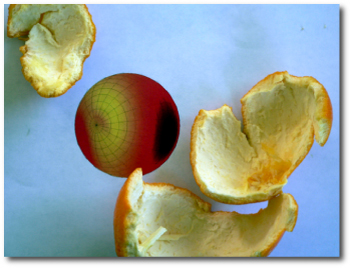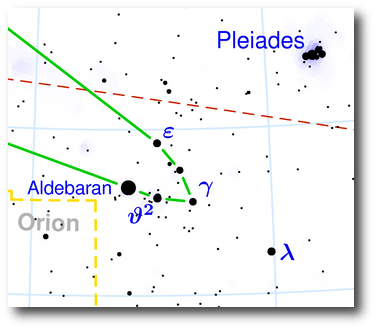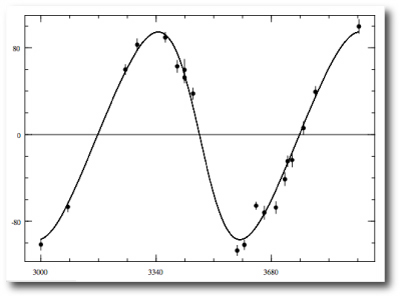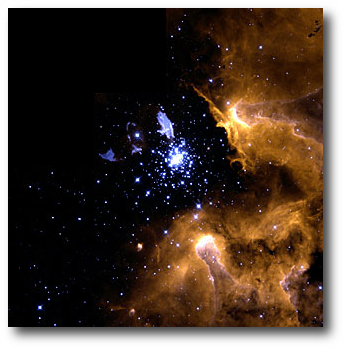
Image Source.
It’s been a hectic week, and now that it’s February, my New Year’s resolution to write 2-3 posts per week managed to lose its shaky option on my priorities.
Eugenio stopped by my office this afternoon to outline his latest code developments for the console. He’s mostly finished implementing a Bulirsch-Stoer integrator. Once this algorithm is tested and operational, it will produce very significant speed-ups for the fitting and the stability analysis of tough multiple-planet systems such as 55 Cancri and GJ 876. Then it’ll be on to a rollout of the bootstrap method for computing uncertainties for the orbital elements in the planetary fits.
“So did you see the new planet?” he asked.
“Huh?” I hadn’t heard anything about it.
Turns out that Bunei Sato and his collaborators have detected a periodic radial velocity variation for the star Epsilon Tauri. Their preprint is on the Astrophysical Journal’s website, but it doesn’t seem to have hit the preprint server yet. This star is a prominent member of the nearby Hyades cluster, and is easily visible to the naked eye as part of the well-known “V”-shaped asterism near Aldeberan in the sky.

Image Source.
Eps Tau is bright enough to have garnered 40 different names in the Simbad catalog, and it’s now listed in the console menu and on the systemic backend as HD 28305. This is one of the most straightforward radial velocity datasets that you’ll come across, and thus makes a good system for first-time users to fit. A few debonair moves with the downloadable console conjure up a model planet with a period of 594 days, an orbital eccentricity e=0.15, and a minimum mass 7.6 times that of Jupiter:

Epsilon Tauri is one of the four stars in the Hyades that are currently nearing the end of their lives and are evolving through the red giant phase. It’s 14 times larger than the Sun, and it’s luminosity is 97 times the solar value. It weighs in at 2.7 solar masses, making it the most massive star known to harbor a planet.
So what’s the story? The Hyades are a metal-rich cluster. One would naively expect that the supersolar composition of the precursor star-forming giant molecular cloud would have lead to a large fraction of the cluster members harboring readily detectable planets. It’s also true that stars somewhat more massive than the Sun should harbor a higher-than-average fraction of giant planets. Eps Tauri scores on both counts.
[Note: John Johnson‘s thesis work at UC Berkeley and Bunei Sato’s RV survey are both capable of providing observational support for the hypothesis of a positive correlation between the detectable presence of a planet and the mass of the parent star. See talk #1 on the Systemic Resources page for more details.]

Young Cluster NGC 3603, Source: NASA
It’s important to keep in mind, however, that a cluster environment will have a strong effect on giant planet formation. Currently, the Hyades are 600 million years old, and the cluster has lost a large fraction of its O.G.s to the general galactic field through the process of dynamical escape. If we extrapolate back to the cluster’s early days, we find that the Hyades would have resembled the Pleiades 500 million years ago, and would have looked like the Orion Nebular Cluster during the first few million years of its existence.
The UV radiation environment in the original Hyades cluster was fierce. The protostellar disks of the individual Hyads were likely photoevaporated before the growing planetary cores were able to reach the runaway gas accretion phase that gives rise to Jupiter-mass planets (see our paper on this topic). When we get the full inventory of planets in the Hyades, I think we’ll find plenty of Neptunes and terrestrial planets, but almost nothing in the Jovian range. Indeed, work by Bill Cochran and the Texas RV group has demonstrated that the Hyades are generally deficient in massive planets.
My guess is that Epsilon Tauri b is an example of a planet that formed through the gravitational instability mechanism. Gravitational instability should generally produce more massive planets (e.g. HIP 75458 b, and HD 168443 b and c) and its efficacy will be little-affected by UV radiation from neighboring stars. It likely occurs once per every several hundred stars that are formed, and so it’s perfectly reasonable that there’s one star in the Hyades that has a planet formed via the GI mechanism.
For more information, this series: 1, 2, 3, 4, 5, 6, and 7
of oklo posts compares and contrasts the gravitational instability and core accretion theories for giant planet formation.

Hello ! :-D
This objet is perahps a light brown dwarf, no ?
After all, we just have the minimum mass.
According to this paper on asteroseismology, Iota Horologii (HR 810) is associated with the Hyades and might be an ejected cluster member.
Are most stars formed in clusters like the Hyades, and if so, how is that reconciled with the frequency of planets around non-cluster stars?
Hi Vincent,
Greg can add to/correct anything I write below.
Sato et al argue that the object is more likely a planet than a brown dwarf, based on how orbital inclinations are distributed. They did not discuss the possiblity of infrared observations. On average, this object is ~1.93 AU or ~15.2 stellar radii from the star (the radius of the star is 13.7 Solar radii), but it comes in as close as ~12.9 stellar radii. The star is ~100 times as luminous as our Sun. Because this object is probably not in a face-on orbit, it’s projected separation from the star should typically be
Hi Vincent,
Here’s the rest of my reply:
Hi Vincent,
Here’s another try:
Hi Andy,
Hopefully, I can eventually get the rest of my response to Vincent’s comment on the site.
I’ll try to address yours here.
Again, Greg can correct me or add to what’s below.
Two things come to mind: timing and the environment. If a (relatively low mass) star with a (relatively high mass) protoplanetary disk is ejected from a cluster before the O, B, and possibly A stars turn on (or soon there after), a planetary system could form in relative “safety.” If there is enough optically thick material between the stars, it could protect a forming planetary system from the intense radiation of O and B stars. When the O and B stars go supernova, the resulting shock waves may actually trigger additional star formation in the surrounding cluster material. It’s also possible that some open cluster may never have had O and B stars in them. Whatever, the situation, the surving low mass stars (F,G,K, and M stars) eventually leave the cluster through dynamical escape. Those left behind have fewer and fewer neighbors over time, making it more likely that any surviving planetary systems will continue to survive.
Hi Vincent,
I finally remembered that the symbol for less than has a special meaning in html. Hopefully, it will work this time.
less than ~ 15 stellar radii or less than ~ 0.04 seconds of arc (based on the star’s distance of 47.5 parsecs). It’s not clear how difficult it would be to detect the object this close to a star this bright. Considering the age of the Hyades (625 Myr), if it were detected in the infrared, it’s brightness could help determine if it’s a planet or brown dwarf. (Greg can correct me here.) I bleieve young planets and brown dwarfs cool off at different rates so that at a given early age, one will appear brighter than the other in the infrared (assuming they have the same radii).
Thanks for the explanation.
You might be able to get the less than sign by using a character escape < – testing – <
Thank you very much Eugenio for your explanations ! :-)
Many years ago, the Hubble telescope found a planet in a globular cluster. See
HubbleSite – NewsCenter – 2003 – 19 – Oldest Known Planet Identified.htm
Many yaers ago Hubble also probed another Globular Cluster, 47 Tucanae, and could find not hot jupiters using the transit method.
I remember being profoundly saddened for it meant that planet formation was not an even or predictable process.
I was also saddened as it destroyed the scientific basis for my guilty pleasure, Stargate Atlantis.
Pingback: Centauri Dreams » Blog Archive » Hyades Planet Challenges Formation Theories
Pingback: systemic - The Perfect Storm